
Liuva I (died 570, [1] 571-572, [2] or 573 [3] ) was a Visigothic King of Hispania and Septimania.

Liuva I (died 570, [1] 571-572, [2] or 573 [3] ) was a Visigothic King of Hispania and Septimania.
He was made king at Narbonne following the death of Athanagild in 567. Roger Collins notes this was the first time a Visigothic king is mentioned in the north-eastern region of the realm since 531, when Amalaric was murdered. He suggests Liuva's coronation near the border with the Franks was because of renewed threats from that neighbor; under Guntram, the Franks are known to have posed more of a threat to the Visigoths. [4] This threat would also explain why in the second year of his reign, Liuva made his younger brother Liuvigild both co-ruler and heir, putting him in direct charge of Hispania Citerior, or the eastern part of Hispania. [5]
The Frankish threat may also explain why Liuva gave shelter to bishop Pronimius (modern French: Fronime). Gregory of Tours states Pronimius had left Bourges to live in Septimania "for some reason or other". Liuva made him bishop of Agde, an office he held into Liuvigild's reign. When that monarch attempted to assassinate him, Pronimius then fled back to Gaul, and eventually made his way to the court of the Frankish king Childebert, who then appointed Pronimius bishop of Vence. [6]
Liuva died in the third year of his rule from unrecorded causes. [7]

Amalaric was king of the Visigoths from 522 until his death in battle in 531. He was a son of king Alaric II and his first wife Theodegotha, daughter of Theoderic the Great.

Alaric II was the King of the Visigoths from 484 until 507. He succeeded his father Euric as king of the Visigoths in Toulouse on 28 December 484; he was the great-grandson of the more famous Alaric I, who sacked Rome in 410. He established his capital at Aire-sur-l'Adour in Aquitaine. His dominions included not only the majority of Hispania but also Gallia Aquitania and the greater part of an as-yet undivided Gallia Narbonensis.
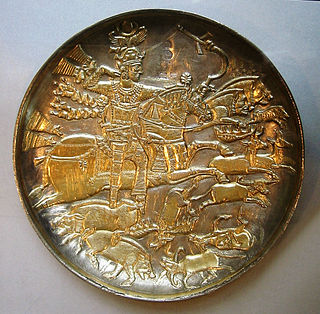
Year 531 (DXXXI) was a common year starting on Wednesday of the Julian calendar. At the time, it was known as the Year after the Consulship of Lampadius and Probus. The denomination 531 for this year has been used since the early medieval period, when the Anno Domini calendar era became the prevalent method in Europe for naming years.

Year 610 (DCX) was a common year starting on Thursday of the Julian calendar, the 610th year of the Common Era (CE) and Anno Domini (AD) designations, the 610th year of the 1st millennium, the 10th year of the 7th century, and the 1st year of the 610s decade. The denomination 610 for this year has been used since the early medieval period, when the Anno Domini calendar era became the prevalent method in Europe for naming years.

Athanagild was Visigothic King of Hispania and Septimania. He had rebelled against his predecessor, Agila I, in 551. The armies of Agila and Athanagild met at Seville, where Agila met a second defeat. Following the death of Agila in 554, he was sole ruler for the rest of his reign.
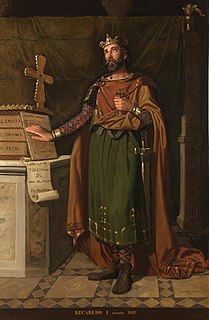
Reccared I was Visigothic King of Hispania and Septimania. His reign marked a climactic shift in history, with the king's renunciation of Arianism in favour of Catholicism in 587.

Gesalic, Gesaleico in Spanish and Portuguese, Gesaleic in Catalan,, was a king of the Visigoths from 507 to 511, and died in 513.
This is a historical timeline of the Iberian Peninsula during the period of the post-Imperial kingdoms.
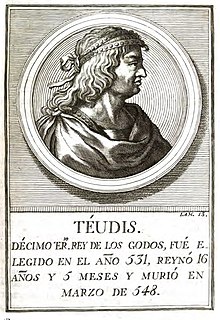
Theudis, was king of the Visigoths in Hispania from 531 to 548.
Agila, sometimes Agila I or Achila I, was Visigothic King of Hispania and Septimania. Peter Heather notes that Agila's reign was during a period of civil war following the death of Amalaric, the last member of the old Visigothic dynasty, when ambitious Gothic nobles competed openly for the throne.

Witteric was the Visigoth King of Hispania, Septimania and Galicia. He ruled from 603 to 610.

Gundemar was a Visigothic King of Hispania, Septimania and Galicia (610–612).

Liuvigild, Leuvigild, Leovigild, or Leovigildo, was a Visigothic King of Hispania and Septimania from 568 to 586. Known for his Codex Revisus or Code of Leovigild, a law allowing equal rights between the Visigothic and Hispano-Roman population, his kingdom covered modern Portugal and most of modern Spain down to Toledo. Liuvigild ranks among the greatest Visigothic kings of the Arian period.
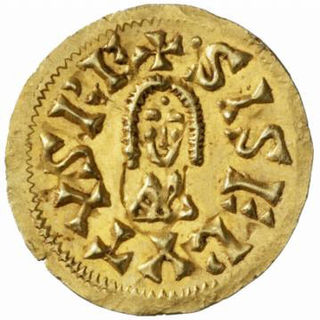
Sisebut was King of the Visigoths and ruler of Hispania and Septimania from 612 until his death.

The Kingdom of the Suebi, also called the Kingdom of Galicia or Suebi Kingdom of Galicia, was a Germanic post-Roman kingdom that was one of the first to separate from the Roman Empire. Based in the former Roman provinces of Gallaecia and northern Lusitania, the de facto kingdom was established by the Suebi about 409, and during the 6th century it became a formally declared kingdom identifying with Gallaecia. It maintained its independence until 585, when it was annexed by the Visigoths, and was turned into the sixth province of the Visigothic Kingdom in Hispania.
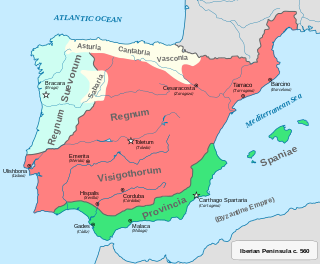
Spania was a province of the Eastern Roman Empire from 552 until 624 in the south of the Iberian Peninsula and the Balearic Islands. It was established by the Emperor Justinian I in an effort to restore the western provinces of the Empire.
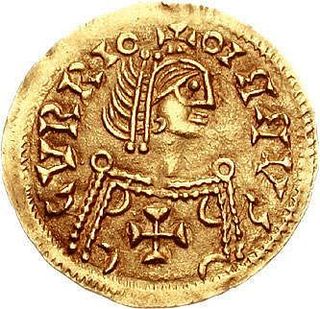
The Visigothic Kingdom, officially the Kingdom of the Goths, was a kingdom that occupied what is now southwestern France and the Iberian Peninsula from the 5th to the 8th centuries. One of the Germanic successor states to the Western Roman Empire, it was originally created by the settlement of the Visigoths under King Wallia in the province of Gallia Aquitania in southwest Gaul by the Roman government and then extended by conquest over all of Hispania. The Kingdom maintained independence from the Eastern Roman or Byzantine Empire, whose attempts to re-establish Roman authority in Hispania were only partially successful and short-lived.
The Historia de regibus Gothorum, Vandalorum et Suevorum is a Latin history of the Goths from 265 to 624, written by Isidore of Seville. It is a condensed account and, due to its diverse sources, somewhat inconsistent. The history of the Vandals is appended after that of the Goths, followed by a separate history of the Suevi.

Theudigisel, was king of the Visigoths in Hispania and Septimania (548–549). Some Visigothic king lists skip Theudigisel, as well as Agila I, going directly from Theudis to Athanagild.
Goiswintha or Goisuintha was Visigothic Queen consort of Hispania and Septimania. She was the wife of two Kings, Athanagild and Liuvigild. From her first marriage, she was the mother of two daughters — Brunhilda and Galswintha — who were married to two Merovingian brother-kings: Sigebert I of Austrasia and Chilperic, king of the Neustrian Franks.